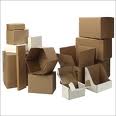
Increasingly, paper mills are using more recycled paper in their paper making operation. This introduces contaminates such as coatings, adhesives, and inks that make bonding and water absorption more difficult for the paper rolls produced.
These paper rolls used in corrugated box manufacturing make the gluing process more difficult due to shorter paper fibers, the desire for greater board strength, and the need for a print surface that enhances print quality. Based on these factors, the most common type of adhesive used in the box making operation today is a resin emulsion.
Resin emulsions or "white glues" are petroleum-based products that replaced dextrins in most glue lap operations because of the factors above and a faster speed of set. Although resin emulsions are slower setting than hot melt adhesives, the polymer advances in technology have allowed a greater range of bonding at a lower cost per pound. In addition equipment cost is lower and maintenance is less troublesome and less costly than hot melt.
The most common resin emulsions used on kraft paperboard, chipboard, and mottel white surfaces are based on poly vinyl acetate polymers. The poly vinyl acetate based adhesives exhibit good machining and easy cleanup. These adhesives can range in viscosity (thickness) from thin for spray applications, heavier for extrusion, and heavier yet for roller or wheel applications
They can also be adjusted in solids level to provide a very quick speed of set in a straight line operation or slightly slower set speed for a right angle, shingle stack compression, or hand applications. Specialty chemicals can be added for greater wet tack or enhanced penetration into tight board.
When special formulations are needed to bond more difficult surfaces, Adhesives formulated from vinyl acetate ethylene co-polymers are typically utilized. These adhesives bond well yet are more difficult to clean because they are more water resistant.
Once a bond is formed with a resin emulsion, it is stable over a very wide temperature range, going from sub-freezing to the destruction point of the paper. This is another reason for their use over hot melt.
In order to make an excellent bond that yields full fiber tear, testing of an adhesive on the corrugated box in a test environment is recommended. This is accomplished by applying a small amount of adhesive to one surface and compressing the two surfaces together for 30 to 60 seconds. If a bond can be formed the starting point is confirmed for the resin emulsion adhesive needed. Then it is a matter of determining the set speed and viscosity required for that particular operation.
The basic premise for the formation of a fiber tearing bond is the liquid adhesive comes in contact with both surfaces and is held together as the water is absorbed leaving the solids portion of the adhesive. It should be noted, if the bond is made, then broken even though the adhesive has yet to dry, the bond is lost and typically cannot be regained.
The adhesive speed of set is controlled not only by its formulation, but also by the amount of adhesive applied and the compression setting. The amount of pressure needed to make a proper bond is critical. The two surfaces have to be snug, but not to the point that liquid adhesive is squeezed out of the glue joint.
The plant environment, its ambient temperature and humidity, will affect the paperboard, and in turn the absorption of the water into the paper, which will impact the speed of set of the adhesive. The higher the solids portion of the adhesive means less water to absorb, resulting in a quicker speed of set.
If your plant is located in the states of Illinois, Michigan, Iowa, Minnesota, or Wisconsin, we would welcome the opportunity to analyze your operation and show the most cost effective selection of adhesive based on substrates, machinery, and environment.
We can be reached at 847-509-7566.
